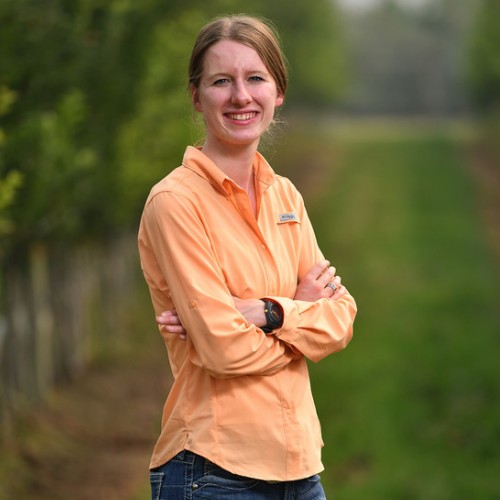Nov 25, 2020Horticulture explores genetics of resistance to fire blight in apples
Sarah Kostick, Ph.D., is making great strides in the world of apple breeding at Washington State University. By investigating resistance/susceptibility to fire blight in apples to enable more efficient development of apple varieties with resistance to fire blight, she has found that specific genomic regions (also called genetic loci) are associated with resistance, and much more.
Fire blight is a devastating bacterial disease that affects a range of apple cultivars (varieties). This disease has the potential to cause tree death and, depending on the year, can destroy entire orchards. Fire blight, caused by the bacterium Erwinia amylovora, can infect the flowers, shoots, and rootstock of the tree, potentially causing tree death. If environmental conditions are conducive to disease development, fire blight infections can result in severe economic losses for apple growers in Washington state.


Sarah works in horticulture with an emphasis in plant breeding, conducting research with WSU Professor of Horticulture, Kate Evans. Most recently, Sarah shared three major highlights that directly correlate to her findings.
Sarah’s data revealed the complexity of inheritance of resistance to fire blight. Her research identified and validated multiple elite sources of resistance. These “elite” sources, i.e., cultivars that have superior fruit quality and resistance to fire blight, may be used as parents in the breeding program.
Sarah said, “I determined the susceptibility levels of 94 apple cultivars. Although most of the apple cultivars I examined were moderately to highly susceptible, I confirmed that several cultivars, including Enterprise and Frostbite, were highly resistant. These highly resistant apple cultivars could be used as parents in breeding programs.”
In the past year, Sarah has published two separate journal articles in collaboration with Professor Evans. In a journal article from 2019, their findings explored the susceptibility levels of 94 cultivars. Most recently, in an article published this year, Sarah, John Norelli, Soon Li Teh, and Kate Evans conducted research and wrote about quantitative variation and heritability estimates of fire blight resistance in a pedigree-connected apple germplasm set.
Sarah wanted to see what the variation in resistance/susceptibility to fire blight levels among progeny looked like when different parents were used. These parents are often important in apple breeding programs. Like human siblings, apple siblings can share certain characteristics.
What the group found is that in most full-sibling families (progeny that share two parents in common) there was variation for resistance/susceptibility to fire blight, including families where both parents were classified as highly susceptible. In other words, when two highly susceptible parents were crossed, most progeny were susceptible, but there were progeny that had low susceptibility levels (lower than either parent). This indicates that a parent’s susceptibility classification is not necessarily indicative of how the progeny will perform.
In a separate section of her research, Sarah used statistical analyses to determine the regions of the apple genome associated with variation. Her findings highlighted three different genomic regions associated with resistance to fire blight.
- Increased understanding of resistance/susceptibility to fire blight in breeding relevant germplasm.
- More informed section of breeding parents. Breeders can use information gained from research studies to select parents in their breeding programs.
- Loci detected can be targeted for DNA test development so that breeders can more efficiently breed for resistance to fire blight.
Sarah successfully defended her dissertation, entitled “Phenotypic Characterization and Genetic Dissection of Resistance to Fire Blight in a Pedigree-Connected Apple Breeding Germplasm Set,” in November 2020. She hopes to continue to hone her skills as a plant breeder as she takes the next step in her career.
– Cynthia Hollenbeck and Elle Ciaciuch O’Neill, Washington State University
Student researcher seeks roots of apple resistance to fire blight















